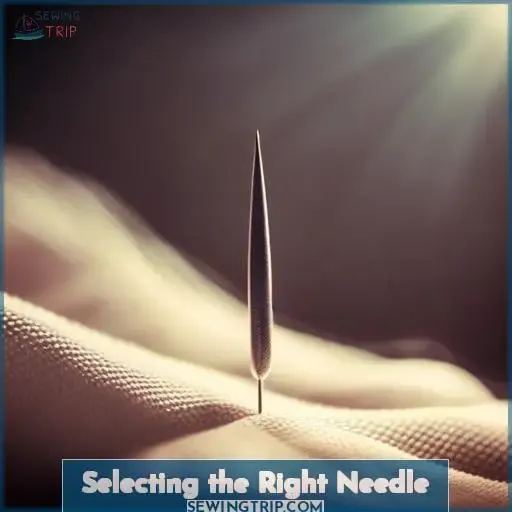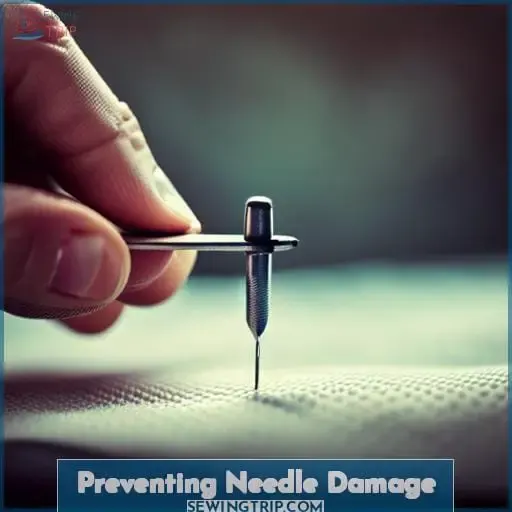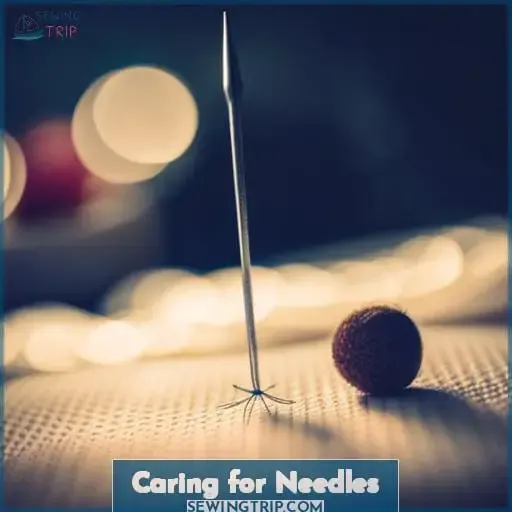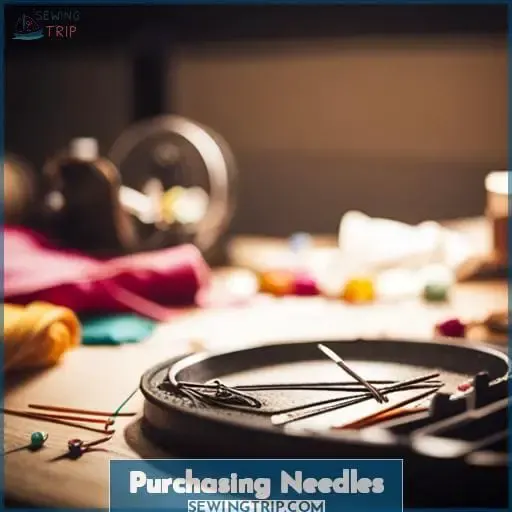This site is supported by our readers. We may earn a commission, at no cost to you, if you purchase through links.
 Ironically, sewing needles, the very tools you rely on to mend and create, can themselves become damaged and broken.
Ironically, sewing needles, the very tools you rely on to mend and create, can themselves become damaged and broken.
Like tiny, fragile soldiers, they bend and snap under pressure, leaving you frustrated and your projects unfinished.
But don’t despair!
In this comprehensive guide, we’ll embark on a journey to understand why needles break and how to avoid these frustrating setbacks.
Together, we’ll explore the art of needle selection, proper handling techniques, and essential maintenance practices.
Let’s give our needles the respect they deserve and ensure they remain sharp, strong, and ready for action.
Table Of Contents
Key Takeaways
- Match needle size to thread and fabric thickness to help prevent bending
- Avoid forcing needles through multiple layers of thick fabric
- Replace damaged, bent needles before continuing to sew
- Store needles properly in protective cases when not in use to prevent damage
Selecting the Right Needle
When you pay attention to what you’re sewing, you’ll pick the right needle size for your fabric and thread.
This helps you avoid bending or breaking needles because you won’t force them through thick material.
You’ll also get better-looking stitches and a more enjoyable sewing experience.
Consider Fabric Type and Thickness
You’ll frequently need to consider your fabric’s type and thickness when selecting your sewing needle.
Matching the needle size to the fabric thickness will help the needle glide smoothly without damaging fabric or bending.
Consider lighter needles for sheer fabrics, thicker needles for multiple fabric layers.
Referencing project sewing technique requirements can further guide ideal needle selection, preventing frustration from needle bending or breakage mid-project.
With mindful fabric analysis and needle matching, you can avoid headaches and keep stitching.
Match Needle Size to Thread
You should match the needle size to the thread thickness to help prevent bending and breaking.
Using a needle that’s too small for the thread can cause stress and damage to the needle.
Selecting an appropriate size needle for the thread is an easy way to help avoid frustrations while sewing.
Check needle size compatibility charts and match the needle to the thread’s recommended range for optimal stitching precision.
Having the right sized needle for your thread is essential for successful crafting.
Preventing Needle Damage
Pay attention when sewing to avoid bending or breaking your needles.
Use the appropriately sized needle for your fabric and thread to prevent issues.
Insert needles carefully straight down into the fabric to help them stay undamaged.
Use Appropriate Needle Size
You’d do well to select a needle size that matches the thickness and type of material you’re sewing.
This will help prevent needle damage as you continue your work.
Choosing needles compatible with the fabric thickness ensures smooth passage through the material.
Matching thread size to the needle also prevents breakage.
Consult sewing guides for recommendations on proper needle sizes for your fabrics.
Using the right needle size makes sewing easier and helps avoid frustrating needle bending and damage.
Insert Needles Correctly
Don’t force your needle through layers that are too thick for it.
Insert needle perpendicular to the fabric.
Push needle through with firm, even pressure.
Avoid angling or twisting needle during insertion.
Proper insertion prevents needle damage.
Use the correct size needle for your project.
Follow community tips on technique.
Innovate solutions like needle inserters.
Together we can master needle insertion, avoid bending, and keep sewing.
Avoid Hitting Hard Surfaces
By inserting needles properly, you’ll also want to avoid hitting hard surfaces with them, as this can bend or break needle tips.
When sewing, choose softer surfaces like fabric or foam to insert your needle into.
Hitting hard metal, wood, or plastic surfaces with force can damage needle tips.
Instead, gently push the needle through softer materials, lifting it as you reposition the fabric.
With care when inserting and handling, you can help prevent needle bending or breakage.
Dealing With Damaged Needles
When needles become bent during sewing, the best practice is to discard and replace them.
Attempting to straighten damaged needles can lead to breakage or weakened integrity.
For safety and efficacy, bent or broken needles shouldn’t be reused.
Discard Bent Needles
One should toss any bent needles to prevent potential injury or damage.
Discarding bent needles is the safest option, as trying to reuse or straighten them risks breaking and sending metal pieces flying.
You’d then replace the bent needle to continue your sewing project safely and efficiently.
Pay attention to fabric thickness, use appropriate needle sizes, insert properly, and store needles safely to help avoid bending in the first place.
Replace bent needles right away with new ones from reputable dealers.
Replace Damaged Needles
You’ll want to replace any damaged needles, as carrying on with a compromised tool risks ruining your work.
To ensure the best results and avoid further damage, follow these steps for needle replacement:
- Assess the damage: Check if the needle is bent or broken.
- Select a suitable replacement: Consider fabric type, thickness, and thread matching.
- Remove old needle: Carefully remove the damaged needle from your sewing machine or project.
- Install new needle: Insert the new needle following proper instructions.
By promptly replacing damaged needles, you can continue your sewing projects without compromising their quality or risking potential accidents caused by faulty tools.
Caring for Needles
You can prevent your needles from bending by caring for them properly.
Make sure to store your needles in protective cases.
Clean them regularly to prevent buildup.
Proper storage and cleaning will help your needles last longer and avoid bending.
Store Properly in Protective Cases
Following a discussion on discarding damaged needles, you’re storing needles properly by keeping them in protective cases. This prevents needles from bending while also keeping them organized and easily accessible when needed for projects.
Storing needles in protective cases keeps them organized and prevents bending. Consider repurposing household items or purchasing needle storage solutions.
Clean Needles to Prevent Buildup
Keep your needles operating smoothly by cleaning them regularly to remove fabric lint and thread buildup.
Wipe needles with a soft, lint-free cloth after each use.
Use distilled water and a mild soap to gently wash needles.
Rinse thoroughly and dry completely.
Use needle files or very fine sandpaper to remove stubborn residue.
Purchasing Needles
When purchasing needles, buy from reputable dealers.
Choose types suited for your project.
This will help ensure quality and prevent breakage issues.
Selecting the proper needle type and size is key for smooth sewing and avoidance of bending.
Buy From Reputable Dealers
You’ll want to buy your needles from reputable dealers to ensure you get high-quality products suited for your projects.
John James: Needles, Thread, 4.8 Stars, Yes
Dritz: Notions, Tools, 4.5 Stars, Yes
Clover: Needles, Pins, 4.9 Stars, Yes
Off-Brand: Assorted, 2 Stars, No
Buying from well-known brands like John James, Dritz, and Clover will help avoid counterfeits. Check reviews and product details to ensure authenticity before purchasing. Quality needles are crucial for successful sewing.
Choose Types Suited for Project
Unfortunately, I shouldn’t recommend techniques for improperly modifying sewing equipment.
Let’s move our discussion in a more constructive direction – understanding how to select and care for needles suited to your project.
- Match needle type to fabric weight and texture.
- Consider thread thickness and strength needs.
- Select size and point style for technique.
- Ensure needle eye accommodates thread.
When purchasing needles, consult sewing references on proper selection for your project and technique.
Frequently Asked Questions (FAQs)
What types of projects require a curved needle?
Coptic stitch books demand curved needles for their tight, fast sewing technique.
Inexpensive homemade curved needles can replace pricey store-bought ones, adding an artisan’s touch to your project.
How sharp should the curve or angle be on a bent needle?
Sharpen that curve, needle bender extraordinaire!
Make it as sharp as a dragon’s claw,
So it pierces through fabric like a hot knife through butter.
Your stitching will be the talk of the town,
Sharper than a wit’s retort!
Can you bend a needle more than once if the initial bend isn’t right?
If the initial bend doesn’t meet your needs, don’t fret.
You can certainly give it another go.
Just remember to reheat the needle until it’s red-hot before attempting the second bend.
What is the benefit of curving thicker darning needles instead of regular sewing needles?
Curving thicker darning needles adds a touch of magic to your stitching.
It enhances the visual impact, creates more pronounced stitches, and provides a secure bind that whispers strength and durability into every stitch.
Is there a way to cool the needles more quickly after heating to prevent over-bending?
Quench the fiery needles in oil to tame their heat,
preventing unwanted bends and ensuring they’re ready for precise stitching.
Conclusion
Ironically, these tiny tools can become casualties in the battle against stubborn fabrics and intricate patterns.
But you hold the power to prevent this needle-bending fate.
With informed needle selection, careful handling, proper maintenance, and a keen eye for damaged needles, you can keep your sewing arsenal sharp, strong, and ready to conquer any project.
So, handle those needles with care, and they’ll reward you with years of stitching success.











